How to Handle Chopsticks: Mastering Beautiful Chopstick Use in Japanese Cuisine
Aug 08,2014
How to Handle Chopsticks: Mastering Beautiful Chopstick Use in Japanese Cuisine
Aug 08,2014
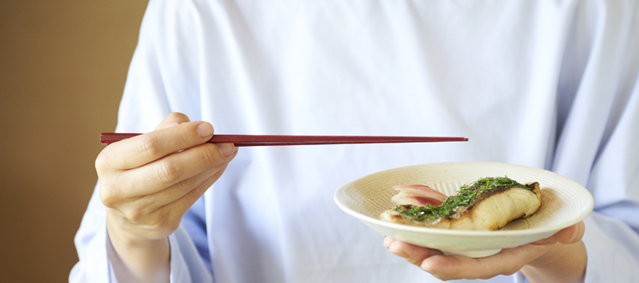
You use chopsticks and dishes every day when eating Japanese food. But do you handle them with grace? Few people can confidently answer yes. Elegant comportment at the dining table not only enhances your own enjoyment. It’s also a pleasure to behold for your fellow diners and those serving you. We asked culinary expert Kubo Kanako for some pointers on how to use chopsticks and dishes during your meal.
First, she offered guidance on the proper use of chopsticks, one of the basics of Japanese culinary etiquette. Many people have at some point asked themselves whether they’re holding their chopsticks correctly. But surprisingly few have ever thought about the right way to pick up a pair of chopsticks.
“There’s a saying in Japanese: ‘Pick up your chopsticks in three moves.’ In other words, it’s a three-step process,” Kanako explains. “If you’re right-handed, first you pick up the chopsticks in your right hand. Then you lightly place your left hand under them and hold them with it for a moment while sliding your right hand to the top. Finally, you move your right hand around to the lower side of the chopsticks and grip them again.” People notice how you pick up and put down your chopsticks more than you might think. Check out the following photos to see whether you’re doing it correctly. After all, it’s an everyday part of eating Japanese cuisine.
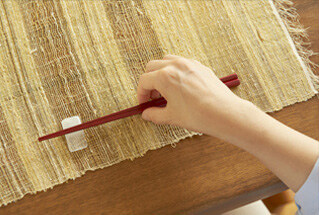
1. Pick up the chopsticks in the center with your right middle and index fingers and thumb.
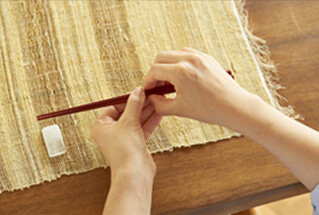
2. Place your left hand under the chopsticks such as to support them, with the fingertips together.

3. Slide your right hand to the top of the chopsticks.
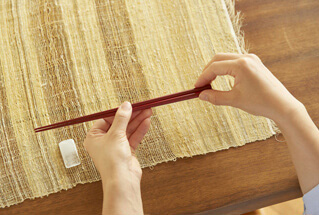
4. Move it around to the lower side of the chopsticks without removing it, then grip them again.
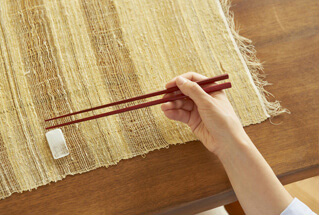
5. Draw the chopsticks toward you. Once firmly gripped, remove your left hand.
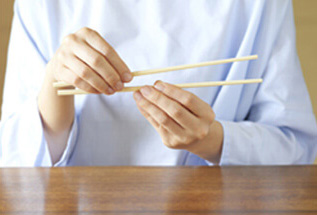
Splitting disposable chopsticks
Hold the chopsticks horizontally, with the ends of the chopsticks facing left, and split them vertically.
Sometimes chopsticks come with a chopstick rest. We asked Kanako the right way to place a pair of chopsticks on it. “You often see people aligning the ends of their chopsticks exactly with the chopstick rest,” she replied. “But if you do that, the part of the chopsticks that goes directly in your mouth comes into direct contact with the chopstick rest. A chopstick rest is originally designed to prevent the ends of the chopsticks from directly touching the table. So when laying down your chopsticks, you should place them with the ends that go in your mouth extending about three centimeters beyond the chopstick rest.”
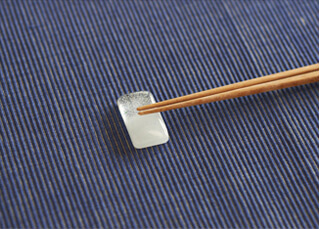
The wrong way to place your chopsticks
With the ends aligned exactly with the chopstick rest
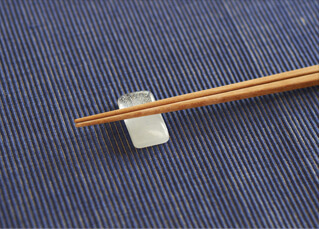
The right way to place your chopsticks
With the ends extending about 3 cm beyond the chopstick rest
If your chopsticks aren’t accompanied by a chopstick rest but come in a paper case, you can use the case to create an instant chopstick rest instead. Simply fold the case into a knot, or fold into two to form a mountain. Then, when you’ve finished eating, you can insert the soiled ends of your chopsticks in the knotted case to conceal them from view, which looks clean and tidy. If you choose not to fold the paper case into a knot, it’s considerate to place the used chopsticks back into the case and fold the end over to show they’re used.
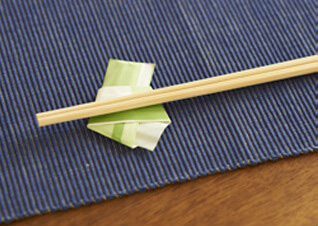
Paper chopstick case folded into a knot
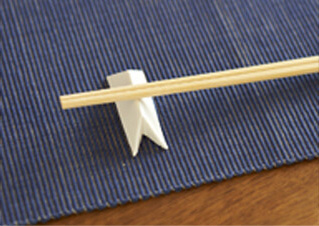
Paper chopstick case folded into a mountain
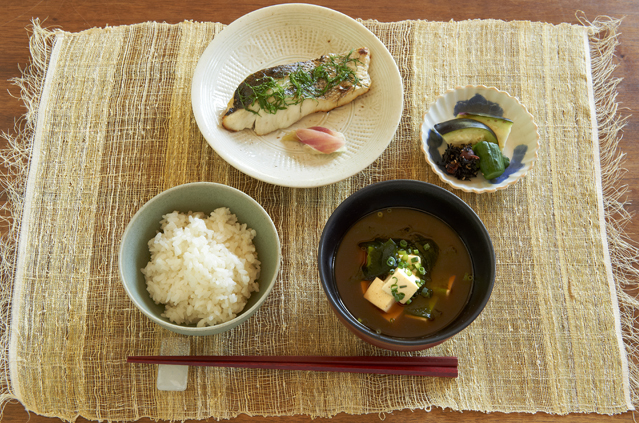
Imagine your meal sitting in front of you. When you start eating, which should you pick up first? Your chopsticks? Your bowl?
The answer is your bowl. First, you pick up the bowl, holding it firmly in both hands. It’s a cherished item, so you wouldn’t want to drop it and break it. Then you transfer the bowl to your left hand. Once it’s securely in place, you pick up your chopsticks with your free (right) hand. Then you insert the chopsticks between the fingers of your left hand as it holds the bowl and, as described earlier, slide your right hand to the top of the chopsticks and grip them again. When you put the bowl down, follow the same steps in reverse, finishing by placing it on the table with both hands.
This method of dining entails putting the chopsticks back on the table every time you pick up a bowl or plate to eat. It’s about appreciating every mouthful while handling each item of tableware with care. It’s a very elegant, very Japanese form of etiquette that shows consideration for others.
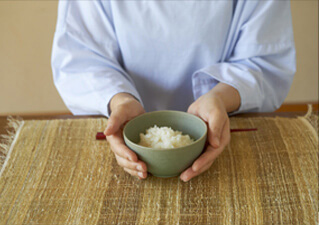
1. Pick up the bowl in both hands.
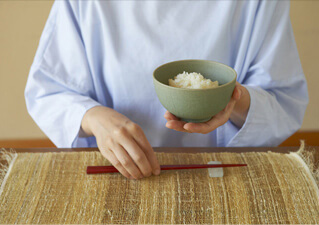
2. Hold it securely in your left hand while picking up your chopsticks with your right.
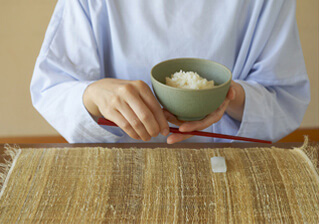
3. Insert the chopsticks between the fingers of your left hand as it holds the bowl. Slowly slide your right hand to the top of the chopsticks.
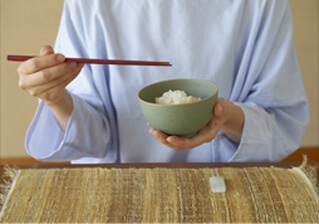
4. Move your right hand around to the lower side of the chopsticks and grip them again, then eat.
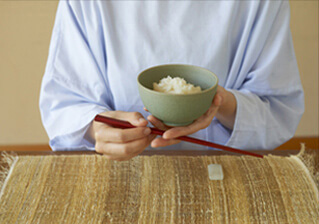
5. When putting the bowl down, follow the same steps in reverse. Insert the chopsticks between the fingers of your left hand as it holds the bowl.
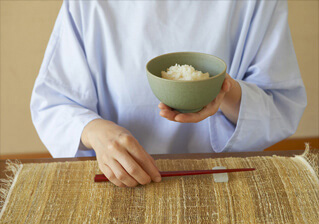
6. Move your right hand around to the upper side of the chopsticks and grip them again, then place them on the table.
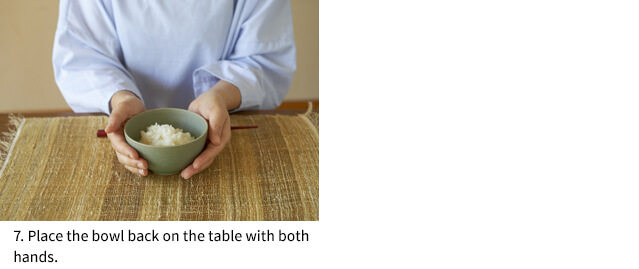
7. Place the bowl back on the table with both hands.

Take a look at the dishes above. Which should you pick up when eating and which should you leave on the table? “In the case of Japanese cuisine,” explains Kanako, “you should basically pick up any dish you can hold in your hand.” When eating foods such as sashimi or tempura served in a large plate or bowl, you can leave it on the table. But it’s better to hold your rice bowl in your hand, as well as any other small bowls, dishes, and plates up to 15 cm wide.
The answer is your bowl. First, you pick up the bowl, holding it firmly in both hands. It’s a cherished item, so you wouldn’t want to drop it and break it. Then you transfer the bowl to your left hand. Once it’s securely in place, you pick up your chopsticks with your free (right) hand. Then you insert the chopsticks between the fingers of your left hand as it holds the bowl and, as described earlier, slide your right hand to the top of the chopsticks and grip them again. When you put the bowl down, follow the same steps in reverse, finishing by placing it on the table with both hands.
This method of dining entails putting the chopsticks back on the table every time you pick up a bowl or plate to eat. It’s about appreciating every mouthful while handling each item of tableware with care. It’s a very elegant, very Japanese form of etiquette that shows consideration for others.
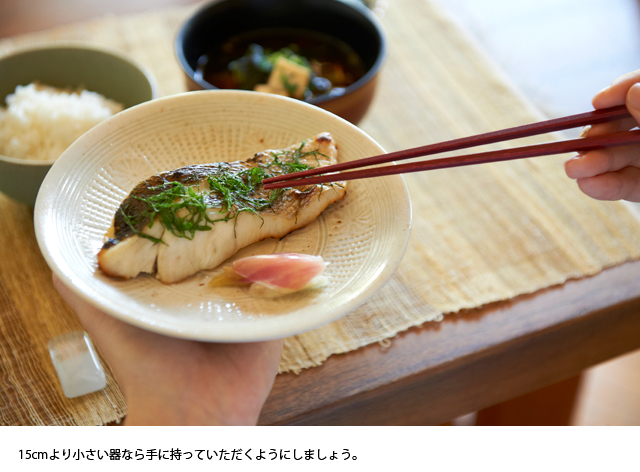
Hold the dish in your hand if it’s less than 15 cm wide.
“You often see people cupping their hand and holding it under their chopsticks like a plate,” adds Kanako, “but it’s hardly an elegant thing to do. The food is liable to drip into your hand. If you really want to do it, the smart thing is to use a napkin.”

You wouldn’t hold a large plate of sashimi in your hand, but holding the dish with the soy sauce prevents it from dripping or spilling. It’s a neat and tidy way to eat.
Properly handling chopsticks and dishes is one of the rudiments of Japanese cuisine, yet for that very reason people are seldom conscious of how they themselves do it. We hope you’ll take this opportunity to master the elegant art of Japanese culinary etiquette and incorporate it into your dining experience.
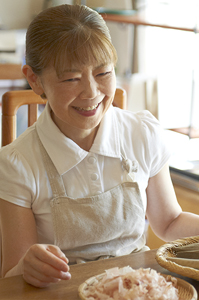
Culinary Researcher
Culinary Researcher
Growing increasingly interested in cooking, Kubo Kanako studied at the long-established Kyoto ryotei (high-class Japanese restaurant) Tankuma Kitamise from the time she was a high school student. After graduating from the Department of English at Doshisha University, she entered the Tsuji Culinary Institute, where she obtained chef’s and fugu (puffer fish) cooking licenses. Following a stint in the Tsuji Culinary Institute’s publications arm, she edited cook books at a publishing house in Tokyo, before going independent.
Today, Kubo is actively involved in a variety of culinary-related endeavors, including culinary production, styling, restaurant menu development, table decorating, editing and more.
She is the author of several works in Japanese, including Utsukushii morituske no kihon [Basics of Beautiful Plating] (Seibido Shuppan), Utsukushii ichiju nisai: “Oishii” to “kirei” in ha wake ga aru [Beautiful Soup and Two Dishes: There are Reasons for “Deliciousness” and “Beauty”] (Kawade Shobo Shinsha), Kichinto, yasai no kobachi chotto shita kotsu de “mō ippin” ga gutto oishikunaru! [Small Vegetable Side Dishes: Little Tips that Make That Extra Something So Much More Delicious] (Kawade Shobo Shinsha), Kichinto, oishii mukashinagara no ryōri [Delicious Old-Time Cooking] and Shun no aji techō aki to fuyu [Seasonal Flavor Handbook: Fall and Winter] (both Seibido Shuppan)